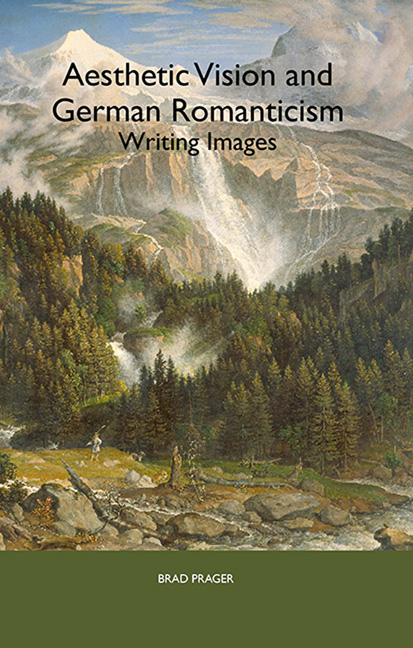Book contents
- Frontmatter
- Contents
- List of Illustrations
- Acknowledgments
- Introduction
- 1 Interior and Exterior: G. E. Lessing's Laocoon as a Prelude to Romanticism
- 2 Image and Phantasm: Wackenroder's Herzensergießungen eines kunstliebenden Klosterbruders, Tieck's Franz Sternbalds Wanderungen, and the Emergence of the Romantic Paradigm
- 3 Symbol and Allegory: Clemens Brentano's Godwi
- 4 Sublimity and Beauty: Caspar David Friedrich and Joseph Anton Koch
- 5 Light and Dark: The Paintings of Philipp Otto Runge
- 6 Absolution and Contradiction: Confrontations with Art in Heinrich von Kleist's “Die heilige Cäcilie oder Die Gewalt der Musik” and “Der Findling”
- 7 Self and Other: Joseph von Eichendorff's Das Marmorbild
- Conclusion
- Notes
- Works Cited
- Index
1 - Interior and Exterior: G. E. Lessing's Laocoon as a Prelude to Romanticism
Published online by Cambridge University Press: 13 April 2017
- Frontmatter
- Contents
- List of Illustrations
- Acknowledgments
- Introduction
- 1 Interior and Exterior: G. E. Lessing's Laocoon as a Prelude to Romanticism
- 2 Image and Phantasm: Wackenroder's Herzensergießungen eines kunstliebenden Klosterbruders, Tieck's Franz Sternbalds Wanderungen, and the Emergence of the Romantic Paradigm
- 3 Symbol and Allegory: Clemens Brentano's Godwi
- 4 Sublimity and Beauty: Caspar David Friedrich and Joseph Anton Koch
- 5 Light and Dark: The Paintings of Philipp Otto Runge
- 6 Absolution and Contradiction: Confrontations with Art in Heinrich von Kleist's “Die heilige Cäcilie oder Die Gewalt der Musik” and “Der Findling”
- 7 Self and Other: Joseph von Eichendorff's Das Marmorbild
- Conclusion
- Notes
- Works Cited
- Index
Summary
Although Lessing was not A Romantic, his writings were important precursors to Romantic thought, especially his 1766 essay on the subject of the Laocoon, which served as a foundational moment in the Romantic discourse on the perception of art. The following chapter provides background for my general argument in that it explores the philosophical consequences of Lessing's assertions about vision, art, and the exterior world. His observations concerning the Laocoon sculpture argue against the power of works of art as they are found “in the outside world” and instead favor aesthetic experience as it is said to occur in the mind's eye. I here interpret Lessing's essay as a variation on the very same question studied by Kant in his Critique of Pure Reason and outlined in my introduction: it is a meditation on the troubled divide between interior and exterior worlds.
The sculpted Laocoon group that was ultimately of such great interest to Lessing was unearthed just outside Rome on 14 January 1506. By the first of July of that year, it had already been brought to its present location in the Vatican. Upon its discovery, it was immediately recognized by the architect Giuliano di Sangallo, who traveled with Michelangelo to the site of the discovery at the request of Pope Julius II. Giuliano reported that it was the very statue described in the Natural History of Pliny the Elder as the work of Agesander of Rhodes and his two sons, Polydorus and Athenodorus. It was found at the subterranean baths of Titus, emperor of Rome (a.d. 79–81), where it had most likely been walled in during the fifth century in order to protect it from attacking Vandals. Debate remains concerning exactly when the group was sculpted. The multiple claims are often taken as indications of whether one prefers to associate it with Classical Greek culture or with that of decadent Rome. It is now generally assumed that the work in question is a Roman copy based on Greek treatments of the same theme, and that it was made between 50 b.c. and a.d. 50.
Pliny's Natural History, written in the first century a.d., concluded with a history of the visual arts from the Greeks up to his own age.
- Type
- Chapter
- Information
- Aesthetic Vision and German RomanticismWriting Images, pp. 17 - 33Publisher: Boydell & BrewerPrint publication year: 2007



